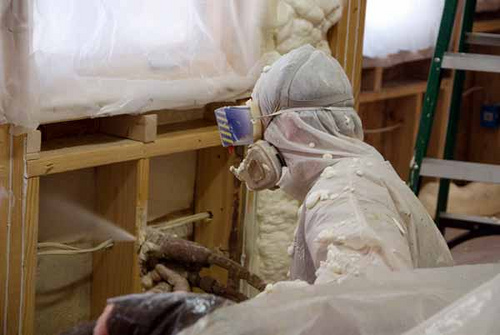Spray polyurethane foam, also known as SPF, has become a popular alternative to other forms of insulation in homes and buildings due to its excellent insulating properties. In many applications, SPF also has an ability to protect against moisture, fill cracks and crevices, and works well to reduce airborne sounds coming through walls, floors and roofs.
https://www.youtube.com/watch?v=D89PdNnP3bQ&feature=youtu.be
https://www.youtube.com/watch?v=D89PdNnP3bQ&feature=youtu.be
There are several types of spray polyurethane foam. The material is applied as a chemical reaction of two components parts takes place as the materials exit an applicator nozzle onto a surface. A foam is formed that then begins to cure.
The U.S. Environmental Protection Agency (EPA) provides information about spray polyurethane foam and states the following: “SPF is an effective insulation and air sealant material; however, exposures to its key ingredient, isocyanates such as “MDI,” and other SPF chemicals that may be found in vapors, aerosols, dust or on surfaces during and for a period of time after installation may cause adverse health effects such as asthma. Therefore, steps to control exposures and safety tips should be followed.”
Isocyanates are chemical substances that are known to be powerful irritants. The EPA reports, “There is concern for exposure to any isocyanate-containing material related to SPF use, including products that contain only a single isocyanate. It is important to understand the other products that contain isocyanates because if sensitized to isocyanates, even low concentrations of isocyanates can trigger a severe asthma attack or other lung effects, or a potentially fatal reaction.”
To prevent chemical exposure during and after installation, SPF applicators should use “best practices” based on the type of SPF product applied as recommended by the manufacturer. This includes vacating building occupants who do not have the proper personal protective equipment, providing appropriate ventilation, isolating the work site to prevent chemicals from spreading to other areas, cleaning the worksite when finished to prevent the spread of particles and dusts, and ensuring that the material has properly cured before others are allowed to re-enter the area.
These are just a few things to know about spray polyurethane foam and potential exposure concerns for workers and building occupants. To learn more about this or other indoor air quality, health and safety, occupational or other environmental issues, please visit the websites shown on the screen.




